#infant baptism
Explore tagged Tumblr posts
Text

#atheist's dilemma#christian#baby#box combo#cane's#christian baby#the box combo#infant baptism#original sin
13 notes
·
View notes
Text
If the validity of Baptism depends on the quality of our faith, then we would all be in great trouble. As Christians we know our faith is not a constant "truth" like a mathematical formula. Two plus two will always equal four. But faith does not work that way. It often wavers, trembles, and doubts. Luther understood this himself. He even likened the fragility of faith to "butter in the sunshine." He often said that the devil is especially busy tempting people of faith because he knows such folk threaten his power as God's chief opponent on earth. So they are special targets of his attacks. As a consequence, faith needs an anchor, or something to which it can cling when it is under assault. And that anchor is Baptism, the most precious "jewel in body and soul." ~Mark D. Tranvik, "Infant Baptism and Saving Faith" in Luther's Large Catechism with Annotations and Contemporary Applications, 624.
5 notes
·
View notes
Text
What is baptism? Is it really that necessary? What is the true meaning of baptism? It is a testimony to our Lord and Saviour, not in means of the cleansing of our sins, but for our newness in Him in good conscience (1 Peter 3:21). Jesus'dwath and resurrection are the baptism He foretold Himself doing (Luke 12:50), and said how He is "pressed until which it would have been completed." He described how painful it will be to go through that kind of baptism, as it involved torture and a humiliating way of dying. He suffered all that for us. But as He resurrected, so will we through the baptism in the future, as we testify through the water baptism. We do it consciously for our Lord and Saviour Jesus Christ, as we give our lives for Him as He dis for our salvation. So it doesn't count if it is an infant baptism, which the later churches made up based on no Scripture in the Bible upholding that tradition. We can't die for Christ unawares, so why does this count as baptism? It doesn't. So I pray that next time you are planning baptism, make sure it is willing for Jesus and not just out of tradition. Tradition is meaningless, if there is no conscious partaking. Bless you in the Name of Jesus Christ our Lord and Saviour! Amen.
#Jesus#Christ#Jesus Christ#evangelism#for all of you#tumblr evangelism#for you#for you all#for all#for believers#for Christians#for the people#for the nations#baptism#infant baptism#what is baptism#what does baptism mean#crucifixion#resurrection#rebirth#reborn#born again#born of water and of the Spirit#Holy Spirit#the Holy Spirit#proper baptism#not tradition#meaning#be baptised willingly#to be baptised
0 notes
Text
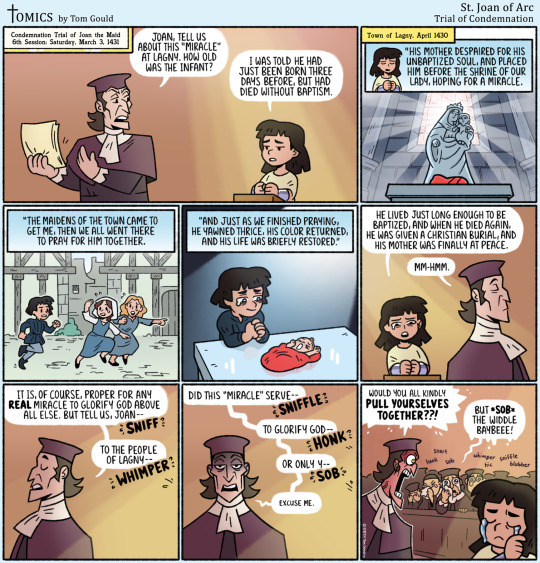
05/10/2024
The widdle baybeee!
___
JOKE-OGRAPHY: 1. This cartoon is based on a story from the 6th session of St. Joan's trial. Before I explain it, here's the original segment, translated by W. S. Scott: "Asked what was the age of the child at Lagny that she went to see, she replied: The baby was three days old. And it was brought to Lagny to Notre Dame. And she was told that the maidens of the town were before [the statue of] Our Lady; and that she might like to go and pray to God and Our Lady that it might live. And she went there and prayed to God with the others. And finally life appeared in it, and it yawned three times; then it was baptised and immediately after died, and was buried in consecrated ground. For three days, they said, no life had appeared in the child; and it was as black as her tunic. But when it yawned, the colour began to come back. And she was with the maidens on her knees in front of [the statue of] Our Lady, offering prayers. Asked if it were not said by the town that she had brought this about, and that it was by her intercession, she replied: I never inquired." 2. To summarize, Joan was in a town called Lagny, where a stillborn child was placed before a statue of Mary in hopes of a miraculous revival. Joan is asked to pray over him with the other young women of the town, and when they finish, the baby is temporarily revived and quickly baptized before dying again. 3. Medieval Catholics believed baptism was essential for salvation, and that anyone who died without it could not get into heaven. Losing a child would've been bad enough without believing their soul was lost too, so although this baby's return to life was only temporary, his quick baptism would have meant the world to his family and community. For those who are curious, the Church still believes that baptism is necessary for salvation, but they also teach that God can offer its graces Himself, without the need for formal ceremony. The sacraments are bound to God, but He is not bound by His sacraments. 4. Though it's not explicitly stated in this part of the manuscript, one of the narratives being pushed by the judges during the trial was that Joan was always out to glorify herself, not God. They ask her if the people of Lagny credited her for the miracle, but in this cartoon, I expand that question a bit to get at what they were really trying to say. 5. For more background on this story, here's one of the sites I referenced: https://www.online-literature.com/anatole-france/joan-of-arc/25/
#catholic#christian#comic#cartoon#catholic memes#jesus memes#christian memes#tomics#bible#jesus#mary#virgin mary#blessed virgin mary#joan of arc#st joan of arc#jeanne darc#st jeanne darc#lagny#miracle#infant#baby#the widdle baybeee#baptism
303 notes
·
View notes
Photo

José Arpa Perea (Spanish, 1858-1952) Baptizmo del Infante Don Juan en Sevilla, 1893
#José Arpa Perea#art#european art#europe#mediterranean#spanish art#spain#classical art#traditional art#procession#baptism#Baptizmo del Infante Don Juan en Sevilla#sevilla#fine art#fine arts#oil painting#spanish#hispanic#latin#hispanola#1800s
55 notes
·
View notes
Text
as excited as i am to work on projects other than the ski masks, i must admit i'm going to miss their supreme portability... is this why so many people get so into knitting socks
#knitblr#(infant death mention in tags) (not anyone i know just in the abstract)#after the ski masks my next smallest project is the baby burial gown I'm making for a local charity#... but I'm a little hesitant to make that my take-everywhere project#just bc one of my favorite parts of knitting in public is chatting w/ strangers who ask what I'm making#and ''baby burial gown'' seems like it might kill the mood a bit#IN THEORY i could lie and say it's for. idk baptisms or something#but i don't like that idea and don't want to do that. doesn't feel right.#also even putting all that aside it's still not as conveniently sized and shaped as the ski masks
3 notes
·
View notes
Text
okay reading about the reformation it seems everyone thinks the anabaptists are heretical but the "baptism only counts if you choose to do it" idea seems... quite reasonable to me?
#but then i see infant baptism as an argument against a benevolent god so i know i have niche opinions on these matters#also i'm an atheist but as with american politics it's hard not to have a opinions about something that's fucking everywhere anyway#it's like how we all know the major 'supernatural' fandom wanks despite not watching 'supernatural'#that wasn't a pun by the way just an unfortunate convergence of unnaturalness in the topics at hand#though despite it being a hot subject in the reformation i find arguments about the presence in the eucharist very boring#i assume that's just one where you really do need to be in the fandom to give a fuck either way?#religion#christianity
6 notes
·
View notes
Text
Time to think abt babies
#my godmother has already set a date for her baby’s baptism. lady it’s still in the oven#it’s halfway cooked#this is too early#but her last baby was the cutest fucking thing ever so!!!!!!! child!!!!! infant!!!!!!
2 notes
·
View notes
Text
i know i have a lot of strong and stupid opinions on theological topics but the baptism debate is so silly to me. who cares at what age you choose to immerse yourself in water as long as you understand the significance of the act and what it represents to you
#or your parents understand. re infant baptism#i think most of the debate comes from people not understanding that different denominations put different meanings on baptism#''infant baptism implies a baby can be saved!'' that's not what that means.#ANYWAY. i also try not to think about this subject too much because if i think about how it relates to my own life i get weird#.txt
6 notes
·
View notes
Text
What non-denominationals think non-denominationalism means: We don't have that tradition and church history and denominations that make those other Christians so sectarian!
What non-denominationalism actually means: Our willful ignorance of tradition, church history and other denominations makes us the most sectarian people around!
Non-denominational Church
What people think it means: We're vaguely Protestant but not really associated with any particular group. That sounds so dogmatic.
What it actually means: We're so dogmatic and fundamentalist that none of the denominations would let us in.
#christianity#american christianity#theology#non-denominationalism#i grew up non-denominational#and only learnt the doctrine of the resurrection of all the dead at the age of sixteen when i started reading the creeds#my younger sister once confidently stated that protestants don't practice infant baptism#and while my church never went through this#I've heard too many cases of non-denominational pastors becoming micro-popes in the worst ways
194 notes
·
View notes
Text
i love baptisms. there was one for a baby today during service and it was so sweet and the baby was so so cute. he tried his best to stick his little fingers in the pastor's mouth while she spoke and gave a blessing, i don't know how she didn't start laughing. i did. his big (but still little) brother did, out loud, which was even cuter and funnier
#every once in a while i don't understand infant baptism even though i do accept it and then i see one and i get it#it's so great welcoming little baby into the community of christ#roach speaks
1 note
·
View note
Text
At this point we come to a question that the devil uses to confuse the world through his sects, namely, about infant baptism. Do children believe, and is it right to baptize them? To this we reply briefly: Let the simple dismiss this question and leave it to the learned. But if you wish to answer, then reply in this way: That the baptism of infants is pleasing to Christ is sufficiently proved from his own work. God has made many holy who have been thus baptized and has given them the Holy Spirit. ~Large Catechism 4:47-49
1 note
·
View note
Text
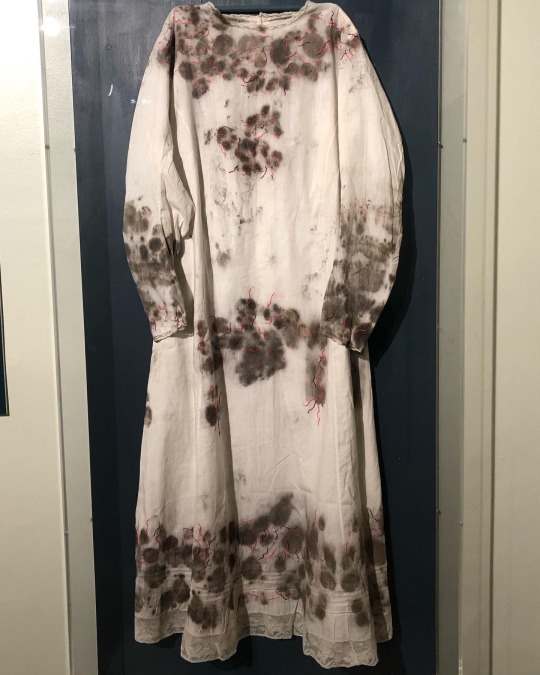
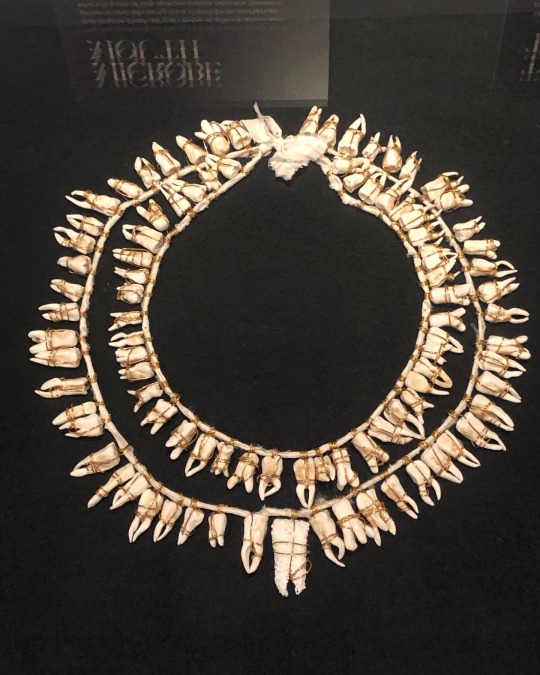
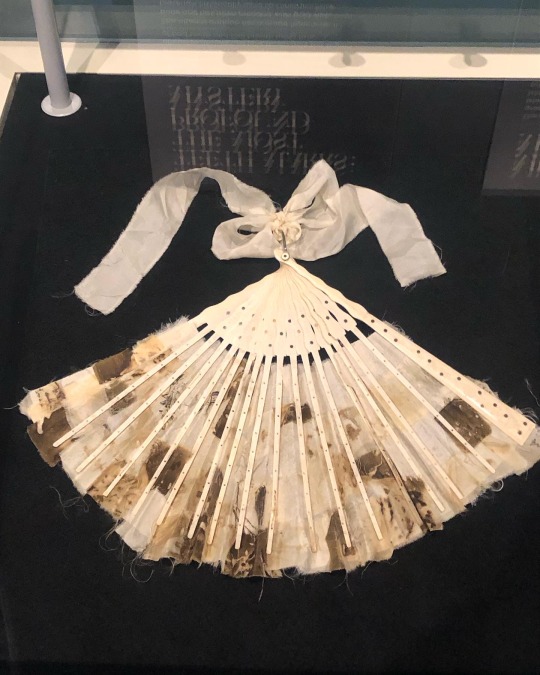


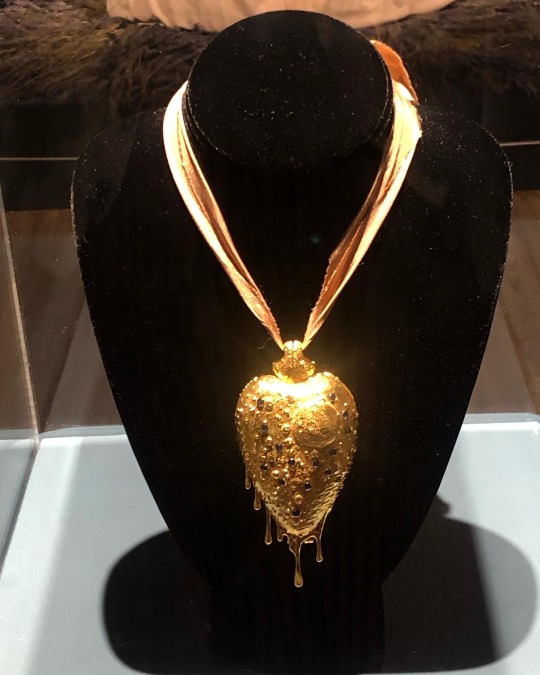
‘Fragile Microbiomes’ by bio-artist Anna Dumitriu
1. SYPHILIS DRESS- This dress is embroidered with images of the corkscrew-shaped bacterium which causes the sexually transmitted disease syphilis. These embroideries are impregnated with the sterilised DNA of the Nichols strain of the bacterium - Treponema pallidum subsp. pallidum - which Dumitriu extracted with her collaborators.
2. MICROBE MOUTH- The tooth at the centre of this necklace was grown in the lab using an extremophile bacterium which is part of the species called Serratia (Serratia N14) that can produce hydroxyapatite, the same substance that tooth enamel is made from.
The handmade porcelain teeth that make up this necklace have been coated with glazes derived from various bacterial species that live in our mouths and cause tooth decay and gum disease, including Porphyromonas gingivalis, which can introduce an iron-containing light brown stain to the glaze.
3. TEETH MARKS: THE MOST PROFOUND MYSTERY- In his 1845 essay “On Artificial Teeth”, W.H. Mortimer described false teeth as “the most profound mystery” because they were never discussed. Instead, people would hide the stigma of bad teeth and foul breath using fans.
This altered antique fan is made from animal bone and has been mended with gold wire, both materials historically used to construct false teeth (which would also sometimes incorporate human teeth). The silk of the fan and ribbon has been grown and patterned with two species of oral pathogens: Prevotella intermedia and Porphyromonas gingivalis. These bacteria cause gum disease and bad breath, and the latter has also recently been linked to Alzheimer’s disease.
4. PLAGUE DRESS- This 1665-style 'Plague Dress' is made from raw silk, hand-dyed with walnut husks in reference to the famous herbalist of the era Nicholas Culpeper, who recommended walnuts as a treatment for plague. It has been appliquéd with original 17th-century embroideries, impregnated with the DNA of Yersinia pestis bacteria (plague). The artist extracted this from killed bacteria in the laboratory of the National Collection of Type Cultures at the UK Health Security Agency.
The dress is stuffed and surrounded by lavender, which people carried during the Great Plague of London to cover the stench of infection and to prevent the disease, which was believed to be caused by 'bad air' or 'miasmas'. The silk of the dress references the Silk Road, a key vector for the spread of plague.
5. BACTERIAL BAPTISM- based on a vintage christening gown which has been altered by the artist to tell the story of research into how the microbiomes of babies develop, with a focus on the bacterium Clostridioides difficile, originally discovered by Hall and O’Toole in 1935 and presented in their paper “Intestinal flora in new-born infants”. It was named Bacillus difficilis because it was difficult to grow, and in the 1970s it was recognised as causing conditions from mild antibiotic-associated diarrhoea to life-threatening intestinal inflammation. The embroidery silk is dyed using stains used in the study of the gut microbiome and the gown is decorated with hand-crocheted linen lace grown in lab with (sterilised) C. difficile biofilms. The piece also considers how new-borns become colonised by bacteria during birth in what has been described as ‘bacterial baptism’.
6. ZENEXTON- Around 1570, Swiss physician and alchemist Theophrastus Paracelsus coined the term ‘Zenexton’, meaning an amulet worn around the neck to protect from the plague. Until then, amulets had a more general purpose of warding off (unspecified) disease, rather like the difference today between ‘broad spectrum’ antibiotics and antibiotics informed by genomics approaches which target a specific organism.
Over the next century, several ideas were put forward as to what this amulet might contain: a paste made of powdered toads, sapphires that would turn black when they leeched the pestilence from the body, or menstrual blood. Bizarre improvements were later made: “of course, the toad should be finely powdered”; “the menstrual blood from a virgin”; “collected on a full moon”.
This very modern Zenexton has been 3D printed and offers the wearer something that genuinely protects: the recently developed vaccine against Yersinia pestis, the bacterium that causes plague.
#my favourite pieces from this exhibition that I visited last month at the Thackray medical museum in Leeds#absolutely fascinating reading about the process and meanings behind these works#mine#anna dumitriu#works
2K notes
·
View notes
Text
it’s not that we don’t bother to baptize the unborn because they’re not persons, we don’t baptize them because we can’t get at them to baptize them!! as Catholics we have strict “matter and form” for sacraments, gestures and words that are the given vehicle for God’s grace. having those things set in stone keeps us from going buckwild and doing stuff, aesthetically and ritually, that’s not in accord with the dignity of what’s happening. and part of the matter of baptism is the anointing with water. this is a necessary part of the sacrament, and since we can’t in the normal order of things get into the mother’s womb to sprinkle an unborn baby with water, we wait until they’re born to baptize them.
however—you know how sometimes modern medicine can detect a birth defect while the baby is in the womb, and then doctors go in and do a partial C-section, do surgery on the baby, and then put them back in the womb to finish developing? hypothetically, you could totally baptize the baby in that brief period where they’re being operated on outside of the womb.
I don't know whom I should ask about this, so I'll just post it and trust that God will give me the right answer at the right time.
Catholics and Lutherans hold that people have to be born before they can be baptized, right? You can't baptize somebody in the womb, and you can't baptize them in the birth canal. They have to be fully born first. This seems to imply that human life begins at birth.
How does this fit together with the pro-life position that human life begins at conception?
#this isn’t even to get into my theory about parents’ desire for baptism for their infant being sufficient for the sacrament—>#miscarried infants being therefore saved by the Baptism of Desire#okay sorry op I’m adding more tags#it’s not about excluding some people from baptism#it’s about the importance of the body!!#we don’t baptize ‘the soul’#we baptize the PERSON#and the person is body and soul!#so the sacrament therefore involves not just prayer for the person—but physical interaction with their body
131 notes
·
View notes
Text
Les Mis Hidden Name Meanings: "Fantine"
Every character's name in Les Mis is either an elaborate pun or has some deeper symbolic thematic meaning — usually both at once.
One example of this is “Fantine.” There’s a wealth of hidden meaning packed into to her name, and some of those meanings are explicitly discussed in the original novel.
The name “Fantine” comes from the french word “enfantine,” meaning “childike, infant-like.” Her name basically means “Baby.” And obviously this speaks to her innocence and naivety. But also “baby” is kind of,.,, well, it sounds more like an informal term of endearment than an actual legal name?
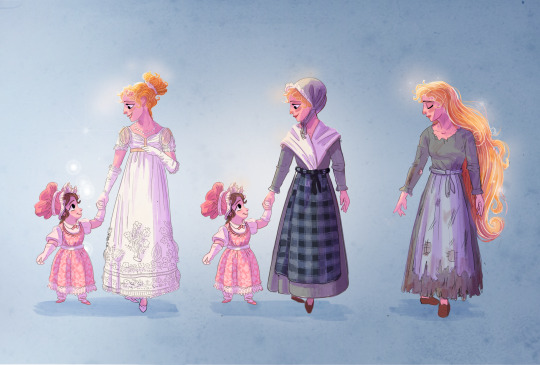
And that’s because– Plot twist– Fantine isn’t her legal name!
What is her legal name? She doesn’t have one.
And the reason she doesn’t have one is directly tied to political turmoil of the era she was born into.
Fantine grew up an orphan living on the streets, without a family without parents. Hugo tells us the origin of her name:
“She bore on her brow the sign of the anonymous and the unknown. (...)She was called Fantine. Why Fantine? She had never borne any other name. At the epoch of her birth the Directory still existed. She had no family name; she had no family; no baptismal name; the Church no longer existed. She bore the name which pleased the first random passer-by, who had encountered her, when a very small child, running bare-legged in the street. She received the name as she received the water from the clouds upon her brow when it rained. “
This moment is adapted beautifully in the Manga adaptation by Takahiro Arai:
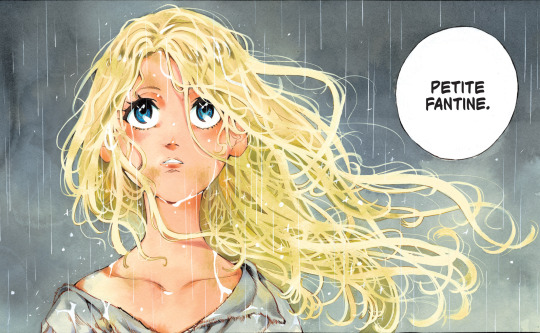

But now let’s talk about the Directory.
To wildly oversimplifly a lot of complex history: Before the French Revolution, the Catholic Church’s records of baptismal ceremonies were often used as a registry of people’s legal names. During the French Revolution, the Revolutionary government– including the Directory– put in place a series of policies we now call “dechristianization,” where they attempted to dismantle the power of the Catholic church.
Fantine was born during the age of these dechristianization policies. So she was likely never baptised, her baptismal name was never recorded, and so she has no documented legal or family name. She’s slipped through the cracks of the legal system, and ended up completely anonymous.
This sets Fantine up as this anonymous child of the Revolution– a stand-in for everyone who was left behind when the Revolution was left behind, and kings were restored to the throne.
Fantine’s namelessness is meant to show her isolation. She has NO support system. She has nothing to connect her to other people, nothing to connect her to a support system.
Finally, the way Fantine tends to “slip through the cracks” is something that follows her throughout her life. When she’s fired from her job at a factory, Mayor Madeleine never learns of it– Fantine has this tendency to be overlooked and forgotten in official records. At the end of the story, she is buried in an unmarked grave, with not even the name “Fantine” on her headstone. She is born anonymous and she dies anonymous.
It ties into the novel’s questions about which people we consider worth remembering, whose lives are worth being recorded.
[Thank you for reading! This essay was originally posted as a video here. For more Les Mis talk, you should subscribe to the 2025 @lesmisletters readalong on Substack here, and join the BrickClub Discord server here!]
#les mis#les mis letters#fantine#les mis hidden name meanings series#les mis tiktoks#:'3#I'm reposting my stuff from Tiktok in Tumblr Grammar!!#It's an Official Essay.#Anyway#this is far more Structured and Polished than my usual nonsense#hope you guys enjoy it!!#I'm gonna bring the Valjean one over.
467 notes
·
View notes
Text
This is going to be a long read! Definite spoilers for those who haven’t finished the first three books so there’s another warning for those of you whom that applies to!
—The Tower is Limbo—
I theorize that the Tower is Limbo and that it is connected in some way to Cannan House due to that being where Jod “ascended” and the location being the strongest connection for human souls because of it. Possibly as the power source Harrow references in GtN. Possibly that is where the extra souls were pulled from to make Teacher and his companions, and also why they’re a little bit batshit. It would be very Jod to be like, “I wasn’t sure what to do with all the souls I ate, so I popped them all in a mind tower on the liminal plane to worry about later. Then once I felt better I pulled the ones I wanted to bring back the most piecemeal, ya know… Jenga.”
I posit the Tower is also connected to Hell in some way, or that Limbo and Hell are one and the same in TLT and I’m just making the connection messier than necessary. I also think Teacher knew about the Devils (see below) when he says, “there are worse things down there” when referencing the labs because part of him was pulled from there and he remembers being in Limbo!
Word Origins: late Middle English; Latin: limbus, 'edge' ‘border’ ‘boundary' ‘hem’ ‘limbo’
Word Definitions:
[1] (in some Christian beliefs) the supposed abode of the souls of unbaptized infants, and of the just who died before Christ's coming.
{a} an abode of souls that are according to Roman Catholic theology barred from heaven because of not having received Christian baptism
{b} In Catholic theology, Limbo, referring to the edge of Hell
[2] an uncertain period of awaiting a decision or resolution; an intermediate state or condition.
{a} a place or state of restraint or confinement
{b} a place or state of neglect or oblivion
{c} an intermediate or transitional place or state
^Varun:
“You left them too long!” - Referring to the souls that Jod had not placed back into flesh vessels and had become corrupted after so long a time left in limbo.
^Devils:
I theorize that the Devils we are introduced to are the unembodied souls that Jod “left asleep” after the resurrection in Limbo, The Jenga Tower. They became corrupted after so long being in Limbo and their envy of the living made them want to possess their bodies and met out some punishment. They are only able to possess and use freshly dead bodies because the soul is -gone-. They can infect a damaged body, but can’t take over until the soul is gone. I can’t think of a better phrasing for this, but I think they’re able to travel the river and pop up where they smell death.
After being “freed” (see Gideon/Kiriona below), the Devils sought out fresh bodies whose souls had departed to possess. I posit that the Devils possessed the bodies of the freshly dead soldiers on Antioch where they are first introduced to us as a scourge due to it being the first major plane of war/death after my Gideon/Kirona theory. I know the fleet was blown up, but those bodies were most likely also blown up and unable to be inhabited.
I theorize that they hit the Ninth House first because that’s where Alecto’s body was stored and the closer her soul came to accepting death while she was galavanting around in Nona made *something* weaker so they could possess the freshly dead old folks there.
*In the case of Collum Asht, his body was left soul-vacant while he was being siphoned and became a prime target for possession in Cannan House which I believe is directly connected to The Tower.
The appearance of the Devils give off a serpentine vibe. Flappy long tongues and sharp teeth. The eyes are the windows to the soul ya know. And they are pissed and -hungry- for life.
[1] The Leviathan is often an embodiment of chaos, threatening to eat the damned when their lives are over. Christian theologians identified Leviathan with the demon of the deadly sin envy.
^Alecto:
I theorize that Alecto is the Leviathan to Jod. We know she is set up to be his end, as she was his beginning. I posit she is the gatekeeper to The Tower, likely unknowingly due to her origin as Gaia, and her little vacation left that gate open and unguarded. Which means… yet another “tomb” unlocked.
I previously posited that Alecto was based on a humpback whale in a previous post (I don’t know how to link it here but it’s in the group!), and her abilities as The Drinker can definitely be classified as a sea monster.
[1]Leviathan also figures in the Hebrew Bible as a metaphor for a powerful enemy, notably Babylon (Isaiah 27:1). Some 19th-century scholars pragmatically interpreted it as referring to large aquatic creatures, such as the crocodile.[5] The word later came to be used as a term for great whale and for sea monsters in general.
^Gideon/Kiriona: Jebus
I theorize that when Gideon sacrificed herself at the end of GtN, her soul dipped into Limbo and “freed” the souls trapped there which is why we only start to see Devils after her “resurrection”. I’m unsure of how/if her soul being spliced will play into this but I do think it was split at least into two (a piece in Harrow absorbed for Lyctorhood and the second in her own body as the Child of Jod (the part that dipped and returned)).
[1] The Catechism of the Catholic Church describes Christ's descent into Hell as meaning primarily that "the crucified one sojourned in the realm of the dead prior to his resurrection. This was the first meaning given in the apostolic preaching to Christ's descent into Hell: that Jesus, like all men, experienced death and in his soul joined the others in the realm of the dead."
—The River is Purgatory—
I theorize that The River is Purgatory because that’s where all the ghosts are waiting to be called back by Jod. We all know our beloved author uses Catholicism like a sneaky guide book in TLT and I found this quote, “the church's understanding has typically been that purgatory has a temporal (temporary, terminating, non-eternal) component with only God being outside of time” when I was spiraling down the rabbit hole and gasped due to just how well it fit! The River is supposed to be a temporary holding place for the souls of the dead, poor hungry ghosts, and we know Lyctors and Jod traverse The River as a way to collapse time and space to get from place to place when needed. We drove along with Nona as she did the same thing!
I’d also like to note that most of the “fire of purification” references are mostly in art and not in the theological sources I looked through. It’s just as likely to be water as water is used as a purifying substance in many different religions. Baptism is a very good example of this.
Word Origin: Middle English: from Anglo-Norman French purgatorie or medieval Latin purgatorium, neuter of late Latin purgatorius ‘purifying’, from the verb purgare (purge).
Word Definitions:
[1] An intermediate state after death for expiatory purification. Specifically : a place or state of punishment wherein according to Roman Catholic doctrine the souls of those who die in God's grace may make satisfaction for past sins and so become fit for heaven
{a} a place or state of temporary suffering or misery
[2] A state of final purification after death and before entrance into heaven for those who died in God’s friendship, but were only imperfectly purified; a final cleansing of human imperfection before one is able to enter the joy of heaven.
{a} This purification is entirely unlike the punishment of hell in that a soul in purgatory is de facto destined for heaven, but must undergo cleansing from all sin before spending eternity in the unbridled presence of God.
—
Please forgive the wonky way this is written, but this is how my brain works (*insert groan here*) when I hyper fixate on figuring something out. There are a lot of notes that are smashed together from multiple sources and some that are blatantly copy/pasted, but I’m not writing an academic paper here so forgive the laziness! Also I have absolutely no clue on how to mark things as spoilers or go back and edit my post as of right now on my phone, which is dumb but alas this is me. And I’m not a theological scholar by any means, so I did try my best to make my ideas as clear as possible with the religious themes.
#tlt#the locked tomb#alecto the first#the locked tomb spoilers#harrow the ninth#nona the ninth#gideon the ninth#alecto the ninth#harrow the ninth spoilers#kiriona the first#nona the ninth spoilers#the locked tomb series#the locked tomb trilogy#gideon the ninth spoilers#gideon nav#harrowhark#harrow nonagesimus#jod tlt#alecto#alecto tlt#alectopause#lyctorhood
97 notes
·
View notes